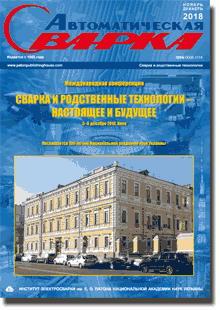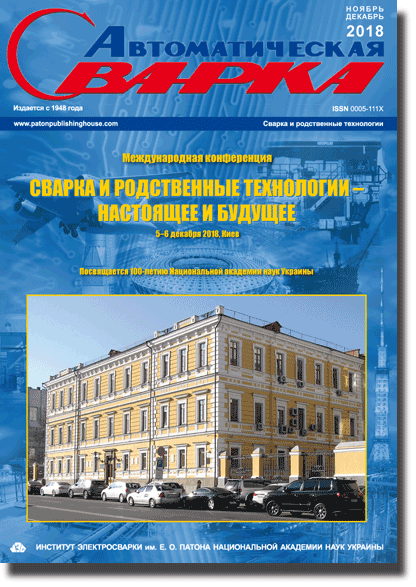| 2018 №12 (04) |
DOI of Article 10.15407/as2018.12.05 |
2018 №12 (06) |

Автоматическая сварка № 11-12, 2018, с. 58-68
Снижение уровня бездеформационных сварочных напряжений термическим натяжением
Гуан Цяо
Китайская инженерная академия, Пекинский научно-исследовательский институт технологии производства авиатехники (BAMTRI). а/я 863, 100024, Пекин, Китай. E-mail: guanq@cal.cn
При изготовлении листовых пластин, панелей и оболочек с помощью сварки деформации продольного изгиба становятся существенными, особенно для аэрокосмических конструкций с толщиной металла менее 4 мм. Для предотвращения потери устойчивости разработаны методы сварки с низким напряжением без деформаций. Эти инновационные методы успешно применяются в производстве аэрокосмических конструкционных компонентов. В статье подробно описаны и обобщены особенности методов сварки с низким напряжением без деформаций с использованием либо полного эффекта термического натяжения поперечного сечения, либо эффекта локального теплового натяжения. Основная идея этих методов сварки заключается в том, чтобы выполнять активное управление процессом характерных пластических (несовместимых) деформаций и напряжений при сварке для получения результатов без деформаций, чтобы не требовалось дорогостоящих операций по повторной обработке после сварки для коррекции геометрии изделий. Особое внимание уделяется анализу по методу конечных элементов для прогнозирования и оптимизации локализованного теплового натяжения с теплоотводом, связанным с источником сварочного тепла. Рекомендуется выбирать параметры для инженерного решения. Библиогр. 21, табл. 1, рис. 15.
Ключевые слова: остаточное напряжение сварки, низкое напряжение бездеформационной сварки, бухтиноватость, термическое натяжение, температурные растяжения, метод конечных элементов
Поступила в редакцию 15.05.2018
Подписано в печать 06.11.2018
References
- Terai, K. (1978) Study on prevention of welding deformation in thin-skin plate structures. Kawasaki Technical Review. (61): 61-66.
- Masubuchi, K. (1980) Analysis of welded structures. Oxford, Pergamon Press.
- Guan, Q. (1999) A survey of development in welding stress and distortion control in aerospace manufacturing engineering in China, Welding in the World, 43(1): 14-24.
- Guan, Q., Guo, D. L. et al. (1987) Method and apparatus for low stress no-distortion welding of thin-walled structural elements. Original Chinese patent 87100959.5. 1988.International patent specification No PCT/GB88/00136.
- Guan, Q., Zhang, C. X. et al. (1993) Dynamically controlled low stress no-distortion welding method and its facility. Chinese patent 93101690.8.
- Zhong, X. M., Murakawa, H. and Ueda, Y. (1995) Buckling behavior of plates under idealized inherent strain. Transactions of JWRI. 24(2): 87-91.
- Michaleris, P. et al. (1999) Minimization of welding residual stress and distortion in large structures. Welding Journal. 78(11): 361-s to 366-s.
- Deo, M. V., Michaleris, P. (2003) Mitigating of welding induced buckling distortion using transient thermal tensioning. Science and Technology of Welding and Joining. 8(1): 49-54.
- Tsai, C. L. et al. (1999) Welding distortion of a thin-plate panel structure . Welding Journal. 78(5): 156-s to 165-s.
- Paton, B. E. et al. (1989) Fabrication of thin-walled welded large panels of high strength aluminum alloys. Svarka. (10) (in Russian).
- Radaj, D. (1992) Heat effects of welding: temperature field, residual stress, distortion. Berlin, Springer-Verlag.
- Guan, Q. et al. (1990) Low stress no-distortion (LSND) welding — a new technique for thin materials. Transactions of Chinese Welding Society. 11(4): 231-237 (in Chinese).
- Burak, Ya. I. et al. (1977) Controlling the longitudenal plastic shrinkage of metal during welding. Svarka (3): 27-29.
- Burak, Ya. I. et al. (1979) Selection of the optimum for preheating plates before welding. Svarka (5): 5-9.
- Mechaleris, P. et al. (1995) Analysis and optimization of weakly coupled thermo-elasto-plastic systems with application to weldment design, J. for Numerical Methods in Engineering. 38:1259-1285.
- Yang, Y. P., Dong, P., Zhang, J. and Tian, X. T. (2000) A hot-cracking mitigation technique for welding high-strength aluminum alloy. Welding Journal. 79(1): 9-s to 17-s.
- Dong, P. et al. (1998) Analysis of residual stresses in Al-Li repair welds and mitigation techniques. Welding Journal. 77(11): 439-s to 445-s.
- Guan, Q. et al. (1996) Low stress no-distortion welding for aerospace shell structures. China Welding. 5(1): 1-9.
- Guan, Q., Zhang, C. X. et al. (1994) Dynamic control of welding distortion by moving spot heat sink. Welding in the World, 33(4): 308-313.
- Li, J., Guan, Q., Shi, Y. W. et al. (2004) Studies on characteristics of temperature field during GTAW with a trailing heat sink for titanium sheet. Journal of Materials Processing Technology. 147(3): 328-335.
- Li, J., Guan, Q., Shi, Y. W. and Guo, D. L. (2004) Stress and Distortion mitigation technique for welding titanium alloy thin sheet. Science and Technology of Welding and Joining, 9, 5, 451-458.
Вартість передплати/замовлення на журнали або окремі статті
| журнал/валюта | річний комплект друкований |
1 прим. друкований |
1 прим. електронний |
одна стаття (pdf) |
| AS/UAH | 1800 грн. | 300 грн. | 300 грн. | 150 грн. |
| AS/USD | 192 $ | 32 $ | 26 $ | 13 $ |
| AS/EUR | 180 € | 30 € | 25 € | 12 € |
| TPWJ/UAH | 7200 грн. | 600 грн. | 600 грн. | 280 грн. |
| TPWJ/USD | 384 $ | 32 $ | 26 $ | 13 $ |
| TPWJ/EUR | 348 € | 29 € | 24 € | 12 € |
| SEM/UAH | 1200 грн. | 300 грн. | 300 грн. | 150 грн. |
| SEM/USD | 128 $ | 32 $ | 26 $ | 13 $ |
| SEM/EUR | 120 € | 30 € | 25 € | 12 € |
| TDNK/UAH | 1200 грн. | 300 грн. | 300 грн. | 150 грн. |
| TDNK/USD | 128 $ | 32 $ | 26 $ | 13 $ |
| TDNK/EUR | 120 € | 30 € | 25 € | 12 € |
AS = «Автоматическая сварка» - 6 накладів на рік;
TPWJ = «PATON WELDING JOURNAL» - 12 накладів на рік;
SEM = «Современная электрометаллургия» - 4 наклада на рік;
TDNK = «Техническая диагностика и неразрушающий контроль» - 4 наклада на рік.





